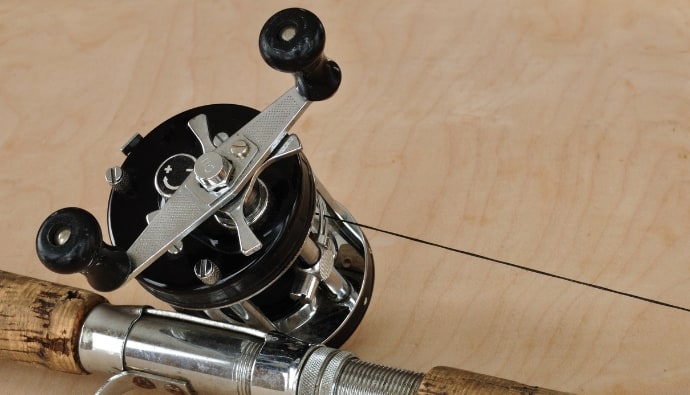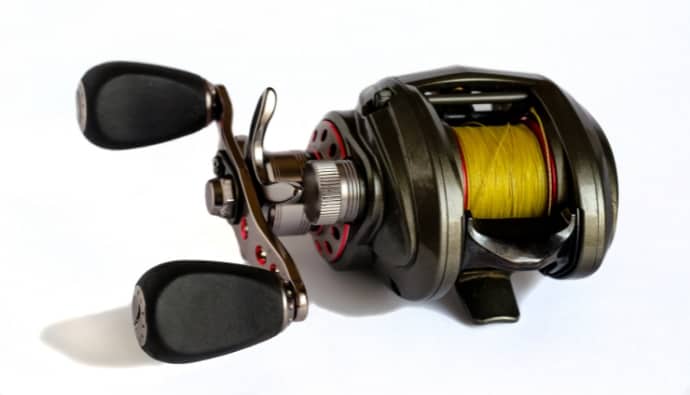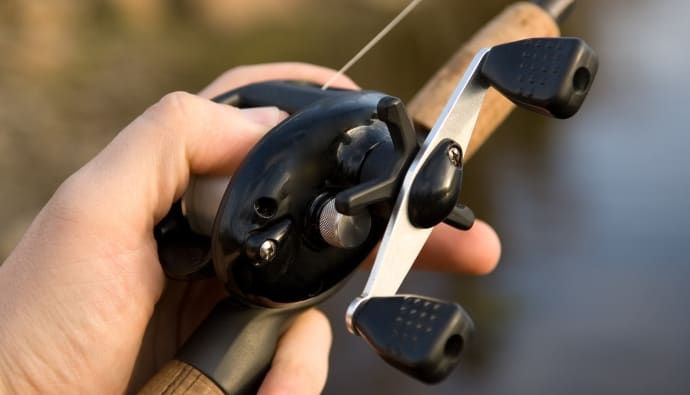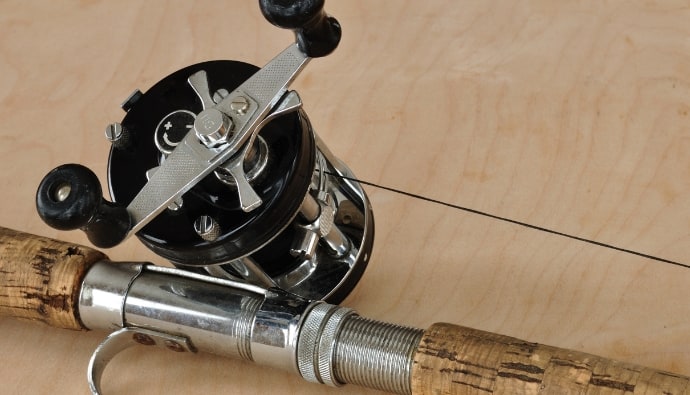The brake system of a baitcasting reel enables anglers to control the spool and prevent backlash. It consists of brake weights on the side of the spool that is adjusted to apply more or less resistance to the spool as it spins. The brake system is essential in casting control, as it determines how easily the spool can be turned and how much line is released during the cast.
A heavier brake weight will provide more resistance and result in a slower and more controlled cast, while a lighter brake weight will allow the spool to spin faster and result in a longer and more powerful cast. To set the brake system of a baitcasting reel, experiment with different brake weight settings and find the one that works best for you.
Different Types of Brakes and How They Work
There are two main types of brakes used in baitcasting reels: magnetic brakes and centrifugal brakes. Some reels may also use a combination of both types of brakes.
Centrifugal Brakes
Centrifugal braking systems use friction pads to slow the rotation of the spool. They are typically adjustable, allowing for fine-tuning of the brake force.
The brake system is composed of a series of friction pads that are located on the inside of the baitcasting reel’s side plate and are held in place by the brake shoe. The pads are mounted on a centrifugal weight system that is attached to the spool.
When the spool starts to spin, the centrifugal weights move outward, away from the spool, and press against the friction pads. The more the spool spins, the more the weights move outwards and the greater the friction against the pads. This creates a braking force that slows the spool’s rotation, allowing for more controlled casting.
The spool tension knob on a baitcasting reel is used to adjust the amount of tension on the spool. This tension, also known as “brake force,” helps to control the speed at which the spool spins when casting.
By increasing the tension, the brake system slows the spool down, reducing the chance of a bird’s nest when casting. Conversely, decreasing the tension allows the spool to spin faster, which can increase casting distance.
Baitcasting reels with a centrifugal braking system offer anglers the following benefits:
- More control
- Less backlash
- Better casting distance
- Increased casting accuracy.
- Easy to adjust: Magnetic brake systems are usually easy to adjust, allowing anglers to fine-tune their equipment for maximum performance.
Magnetic Brakes
A magnetic braking system is a type of braking system used to control the speed of the spool as it spins during a cast. This brake type uses a magnet to hold the brake pads in place to create resistance against the spool. It is based on the principle of like poles repel.
During casting, the spool rotates, and the magnets within the brake system push against each other, creating a resistance that slows the spool’s rotation. This helps to prevent the line from tangling and allows for more accurate casting. And because the magnets are close to the spool, they create more drag force, which helps to moderate the spool rotation.
When the angler casts, the spool initially spins rapidly. But as the lure reaches the end of the cast, the magnets gradually slow the spool down, ensuring the lure lands in the desired location. This feature is particularly useful for beginners learning to cast, as it helps to keep the spool rotation under control.
Some benefits of a magnetic braking system include the following:
- Eliminates bird nesting.
- Greater casting distance because the spool isn’t spinning as fast, which eliminates the occurrence of wind knots.
- Increased casting accuracy is especially useful when casting to specific targets or in tight spaces.
- Smoother casting: Magnetic brakes tend to be smoother than centrifugal brakes, which makes for a more pleasant casting experience.
- It can be adjusted to suit the angler’s casting style and the conditions they are fishing in. This allows anglers to fine-tune their equipment for maximum performance.
- No wear and tear: Magnetic brake systems typically have no wear and tear, which means they last longer than other types of braking systems.
How Brakes Affect Casting
Here are two ways brakes affect casting:
1. Controlling Spool Speed for Improved Casting Distance and Accuracy
The braking system on a baitcaster regulates the speed at which the spool rotates as the baitcaster fishing line is cast. It applies friction to the spool through a series of brake pads or centrifugal brake force.
When the brake is applied, the angler applies more force to the line, which slows down the speed at which the spool spins. This regulates the amount of line released from the reel during the casting process resulting in longer, more accurate casts. This is especially handy when casting with heavier lures or windy conditions, as it prevents the spool from overrunning.
The brake can also be adjusted to provide less resistance, improving casting distance. Loosening the brake makes the spool spins faster, allowing the angler to cast farther. The tighter brake systems keep the spool from spinning too fast and allowing too much line build-up.
By controlling the spool speed, the angler has power over the cast distance and accuracy. It helps determine the casting style and type of lure or bait to be used.
2. Preventing Backlash and Tangles
The braking system on a baitcaster helps to prevent backlash by slowing down the rotation of the spool as the line is cast. Backlash is observed when the spool spins faster than the lure or bait being cast, causing the line to pile up on itself and create tangles.
When the angler casts the line, the spool begins to rotate, pulling the line off the spool. If the spool is rotating too quickly, the line can come off the spool faster than it is being cast, which causes a tangling or bird’s nest.
The braking system works by applying a force that counteracts the rotation of the spool, slowing it down so that the line comes off at a controlled rate. This allows the angler to cast the line with more precision and control, which reduces the likelihood of tangles or backlash.
As the spool begins to rotate during a cast, the brake pads move outwards, coming into contact with the spool and slowing its rotation. This manages the amount of line released, reducing the chances of backlash and tangles.
How to Cast a Baitcaster with No Brakes
Casting with a baitcaster with no brakes can be tricky, but the key is to control the speed of the spool with your thumb. Here are the basic steps to follow:
Step 1: Hold the baitcaster with your dominant hand, and place your thumb on the spool.
Step 2: Hold the rod with your other hand and position the bait or lure where you want to cast it.
Step 3: Use your thumb to apply pressure to the spool as you begin to backwind the line.
Step 4: Use your other hand to guide the rod back in a smooth, sweeping motion as you backwind.
Step 5: As the rod reaches the 12 o’clock position, release the thumb pressure on the spool, allowing the line to flow freely.
Step 6: As the rod continues to sweep forward, guide the rod tip toward your target.
Step 7: Release the bait or lure at the desired location by releasing the line from your fingers or thumb as the rod reaches the forward position.
It’s important to find a comfortable pressure to put on the spool with your thumb and a consistent release pattern, so you don’t overshoot your spot. It takes a bit of practice to get the timing and motion right. Start with a light lure and practice in an open area until you feel comfortable with the technique.
Conclusion
To sum everything up, baitcaster brakes are an essential part of the casting process. Learning how to adjust your brakes properly is crucial to achieving optimal baitcasting performance.
Take into account the size of your reel, the weight of your lure, and the speed at which you are casting to help you choose from centrifugal brakes, magnetic brakes, or both.
Whether you are a weekend angler or a tournament pro, remember that brakes give you extra control over your cast and should be used more as a tool than an afterthought. With proper practice and adjustment of this feature, you can maximize your baitcasting reel potential for improved accuracy and distance casting on any waterway.





 Facebook
Facebook YouTube
YouTube







